 The Times (Shreveport Louisiana) (AP) Convicted of the murder of a carry-out store owner in his hometown of Perryburg, Ohio, in 1978, and sentenced to life in prison, Floyd Fay, 26, was exonerated in 1980 after spending two years in London Correctional Institute. Following his release, Fay vowed to continue the fight he started from his prison cell against the use of polygraph tests, one of the keys to his August 1978 aggravated murder conviction. On March 28, 1978, Ery was behind the counter at Andy’s Carry-Out talking to a customer when a man wearing a blue ski jacket and a full ski mask, and carrying a sawed-off shotgun entered the store. After a short exchange of words, the man fired one shot and left the store. Ery was hit in the neck and shoulder area and collapsed. When a police officer arrived at the scene, Ery told him that, “It looked like Buzz, but it couldn’t have been.” Ery died five hours later, after repeating that “Buzz did it.” “Buzz” was identified as Floyd Fay, a Perrysburg resident and Conrail employee. He was charged with aggravated murder, an offense which, in Ohio, was punishable by death. Shortly before trial, the death penalty was declared unconstitutional by the U.S. Supreme Court. In May 1978, after two months in prison, Fay submitted to a polygraph examination. The prosecution offered him a deal. If he could pass the polygraph test, the charges against him would be dropped. If he failed the test, the results could be used against him as evidence. The test was administered by Ohio’s Bureau of Criminal Identification and Investigations, and Fay failed the test. He was then taken to Dearborn, Michigan, to be tested again, and he failed once more. Both examiners determined that Fay was not truthful. They agreed that he was lying when he denied committing the murder. Circumstantial evidence against Fay included the identification by the dying Fred Ery, even though the perpetrator was wearing a ski jacket and a full mask. The perpetrator also used a sawed-off shotgun, and Fay had a shotgun. Although Fay had no prior criminal record, the polygraph sealed his fate. Hearing this evidence, a jury convicted him of aggravated murder in August 1978. Because of the change in federal law, he escaped the death penalty and was sentenced to life in prison. Fay’s efforts from jail to win a new trial failed, but he did attract the attention of polygraph experts. After they reexamined the questions and results, the experts agreed the lie detector tests had been misread. Public defender Adrian Cimerman, who worked as an intern investigator during the trial, had remained convinced that Fay was innocent, telling the press, “The evidence wasn’t there…he had no criminal record and there was no motive.” While in prison, Fay read numerous books and articles concerning lie detector tests. A polygraph measures certain involuntary bodily changes that are assumed to occur when a person is not telling the truth. During the two years that Fay was incarcerated, he coached 27 inmates, who all freely confessed to him that they were guilty, on ways to beat the control question polygraph test. After only 20 minutes of instruction, 23 of the 27 inmates were successful in defeating the polygraph examination. In 1980, Adrian Cimerman accepted a request from Fay to review his case. Acting on a tip, Cimerman uncovered evidence pointing to the actual perpetrators – shooter William Quinn, lookout Clifford Markland, and driver Ted Goodman. Quinn bore a strong physical resemblance to Floyd Fay. In exchange for immunity, Goodman confessed to his role in the crime and admitted that William Quinn had shot and killed Fred Ery. Quinn and Markland both pleaded guilty to the murder. On October 30, 1980, charges against Floyd “Buzz” Fay were dropped and he was released from prison. He filed a $40 million lawsuit against the Perrysburg police department, the Bureau of Criminal Identification and Investigations, a polygraph examiner, and Wood County commissioners. He ultimately received $129, 867 in compensation from the state of Ohio in 1988. - Dolores Kennedy
|